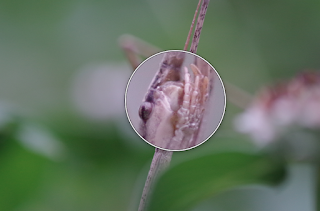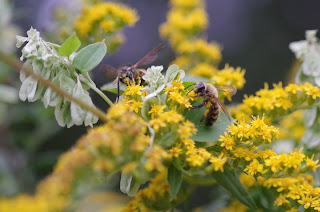I have been looking for YEARS for a certain bug, feeling extreme bug envy whenever I see a picture of one that someone else has found elsewhere. I have searched, and searched, and searched, all the while knowing that it was something that would be so hard to find, and I might never, ever see one. And then today, I just happened to glance in the right direction, at the exact right spot, recognizing something that blends in extraordinarily well with its environment. This isn't just a new bug for me and my backyard. This is a GOAL bug, one I have actively sought, one I have wished for, and despaired of ever seeing. And I realize that it makes me a total geek, and probably a real weirdo that I even HAVE goal bugs, but I do, and I finally found the biggest of my goal bugs.
I finally found a stick insect in my backyard.
Backyard Co-Bug of the Day #1:
Stick insect. I've had a hard time figuring out what species it is, because the books are confusing, and most of them don't have many species in them, but it might be a slender-bodied stick insect, Manomera blatchleyi [Edit: or not. More searching says it's the wrong color for that species]. Evidently they lay their eggs in leaf litter in the autumn, so that is why you find them down low; they spend most of their time high up in trees, so you don't see them.
It is a wondrous thing.
I have always thought that one of the great things about stick insects is that they don't have wings, so if you're trying to take a picture of one, they can't just fly away. It turns out they can crawl and climb kind of fast, so it's pretty easy for them to get away. In fact, after I spent a few thrilling minutes watching and photographing this incredible insect, I walked away to finish my bug walk; because I was almost finished it only took a few minutes, and when I went back to look at the stick insect again, I couldn't find it. It had crawled into the tangle of vines, and I didn't see it again.
Close-up of the underside of its face... if you can call it a face?
I am Groot.
Backyard Co-Bug of the Day #2:
Beetle. This one is probably a bit of a letdown, but I made it Co-Bug of the Day because I think it might be a new species for me. I couldn't find it in the book, though.
Let's take a moment here to appreciate the fact that I found two new species of insects in my backyard today, and in the last couple of weeks I have found quite a few new species. I have been photographing the bugs in my backyard since 2012; this is the 6th summer I have spent doing this, and I am still finding things out there that I have never seen before. It's incredible to me. Obviously I knew that the world is full of insects of a mind-blowing variety, tens of thousands of species of bees, for example, and that's a fraction of the number of species of beetle. I just never thought that my little bit over an acre in Connecticut could have so many. And stick insects–I used to think they were just a rain forest kind of insect. I was shocked to find out that we have them in North America, and in my region of the country. And ever since then I have been looking for one. Sigh. Great bug day in the backyard.
Here's three species right here on the goldenrod:
Bumblebees, an ailanthus webworm moth, and a fly.
Wasp
Grasshopper. I have several species of grasshoppers in my backyard. If you had asked me 20 years ago I am not sure I would have been aware that there are more than one species of grasshopper. I didn't know a lot about bugs back then, and I thought about them even less.
The dragonflies continue to be uncooperative.
Cricket. If you've been reading this blog for a while, you can probably tell that this is a female.
Today I found a bigger specimen of the brown hooded owlet moth caterpillar, and I decided to photograph both of them with the camera at the same distance, so you can see the size difference:
Fall webworm caterpillar that has just shed its skin.
The elephant mosquito was back on the same tree today. I don't think I mentioned yesterday that they lay their eggs in small pools of water in holes in trees. You always hear that the way to control mosquito populations is to make sure you have no standing water in your yard, but I don't think there is anything I can do about tiny puddles in holes up in trees. However, if the elephant mosquito is around to lay eggs there so that their larvae can eat other mosquito larvae, at least someone is taking care of the problem.






























No comments:
Post a Comment